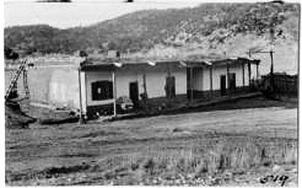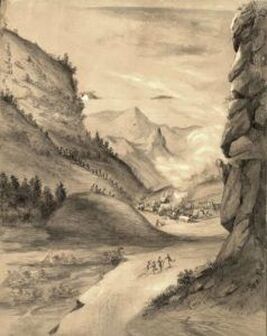Johnson's Ranch, the Third in Glorieta: The Battle of Three Ranches
 Johnson Ranch, 1917 Three ranches figure prominently in the action surrounding the March 26-28, 1862 Battle of Glorieta Pass. The first was Martin Kozlowski’s ranch. Situated at the eastern entrance of this narrow pass in the mountains east of Santa Fe, this location served as headquarters for the Union Army. The second, Pigeon’s Ranch, sits near the top of the pass and is where the main battle took place. The third site, Johnson’s Ranch, is located at the western end of Glorieta Pass, and was where the Confederate camp was located. All three ranches were also waypoints along the Santa Fe trail, which wended through Glorieta pass before dropping out of the mountains to its western terminus in Santa Fe.
Johnson Ranch, 1917 Three ranches figure prominently in the action surrounding the March 26-28, 1862 Battle of Glorieta Pass. The first was Martin Kozlowski’s ranch. Situated at the eastern entrance of this narrow pass in the mountains east of Santa Fe, this location served as headquarters for the Union Army. The second, Pigeon’s Ranch, sits near the top of the pass and is where the main battle took place. The third site, Johnson’s Ranch, is located at the western end of Glorieta Pass, and was where the Confederate camp was located. All three ranches were also waypoints along the Santa Fe trail, which wended through Glorieta pass before dropping out of the mountains to its western terminus in Santa Fe.Like the other two ranches, the owner of Johnson’s Ranch, a Missouri native named Anthony D. Johnson, was known to be strong Union supporter. At the first appearance of the Southern Army, Johnson took his New Mexican-born wife, Cruz, and their five children, and fled into the hills, where they camped in the frigid weather until it was safe to return home.
 An etching of the burning of the Confederate supply train, with Confederates fleeing toward Santa Fe. If you look closely, you can see a line of Union Soldiers on the left, climbing away from the flames. On March 28, the second day of the battle, Confederate Major Charles L. Pyron and Colonel William thought their camp, far to rear, was safe. Thinking no Union forces could get by them through the narrow pass, they left their 80 supply wagons lightly defended with just one canon and a small contingent of soldiers. Most of the remaining men in camp were either injured or ailing.
An etching of the burning of the Confederate supply train, with Confederates fleeing toward Santa Fe. If you look closely, you can see a line of Union Soldiers on the left, climbing away from the flames. On March 28, the second day of the battle, Confederate Major Charles L. Pyron and Colonel William thought their camp, far to rear, was safe. Thinking no Union forces could get by them through the narrow pass, they left their 80 supply wagons lightly defended with just one canon and a small contingent of soldiers. Most of the remaining men in camp were either injured or ailing.It never occurred to the Confederates that the Union Army could attack their supply train, but that is exactly what Colonel John M. Chivington did. He led a flanking party over Glorieta Mesa, on the south side of the pass. Chivington’s men then climbed down the steep bluff and captured the Confederate guard. They spiked the cannon and burned the Texan supply train. He also ordered that Confederate’s draft mules be bayoneted.
When the Confederate Army, fighting at Pigeon's Ranch, learned the fate of their supply train, the battle ceased. The Confederates began the slow process of withdrawing, first to Santa Fe, then down the Rio Grande to Texas. After the battle, Johnson later testified that after the battle, he was forced to transport sick and wounded Texans back to Santa Fe.
For the Johnson family, the invasion proved an economic disaster. They returned to find that Confederate soldiers had looted the house and ranch. They had taken a barrel of whiskey, ten bags of flour, 20 bushels of corn, sugar, molasses, soap, his clothing, and even his canned oysters. They had burned his furniture and fences as firewood. His house and the stagecoach station had nothing left to them but their bare walls. Johnson filed a claim against the U.S. government for $4,075, but there is no record that his claim was ever paid. Luckily, he had the foresight to drive his cattle into the hills, so he had not lost everything.
Eventually, the Johnsons recovered and got back to the business of operating their stage stop and cantina on the old Santa Fe Trail. He acquired wagons and ran a freight service that hauled goods to and from Fort Union on the edge of the plains. In late 1869, he moved his family to Trinidad, Colorado, just north of Raton Pass. Soon, Johnson hauled ties for the advancing Atchison, Topeka and Santa Fe Railway. In early 1879, Johnson was attacked and killed by highwaymen at a river crossing just east of Springer. His body was never found, and although the culprits were captured and brought before a federal judge in Santa Fe, the trial record has been lost and it is unknown what happened to the highwaymen.
The historic Johnson’s Ranch building lasted nearly 90 years longer than its owner. The building which had been a stage station on the historic Santa Fe trail and sheltered a Confederate Army for a few days was bulldozed in 1967 to make room for Interstate 25, that connects Denver to El Paso. Johnson's Ranch is one of the settings for Jennifer Bohnhoff's historical novel Glorieta, which is available in ebook and paperback. Glorieta is the second in a series of novels about the Civil War in New Mexico. The first is Valverde.
Mrs. Bohnhoff lives in the mountains of central New Mexico. From her north-facing windows she can see Santa Fe and the mountains through which Glorieta Pass travels.
Published on March 23, 2020 00:00
No comments have been added yet.



